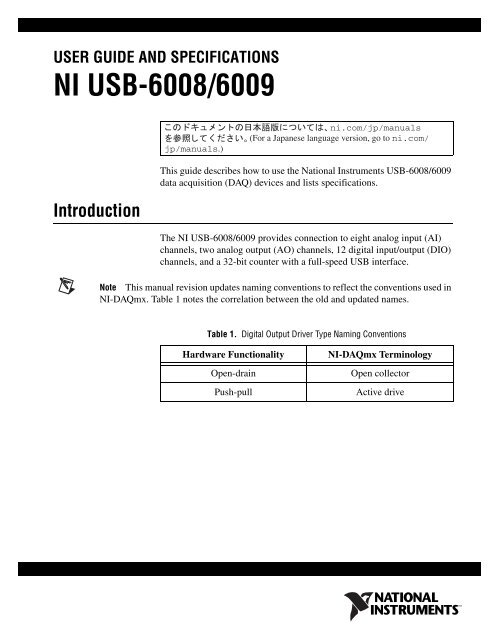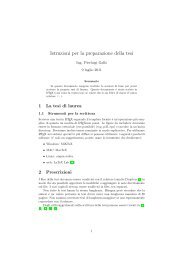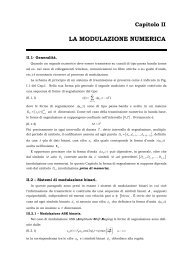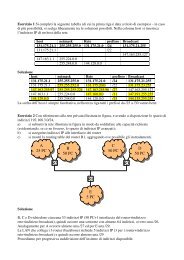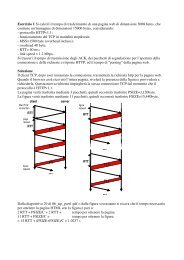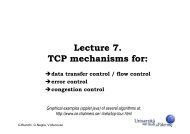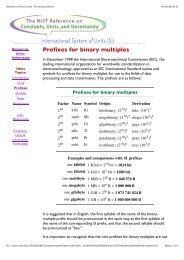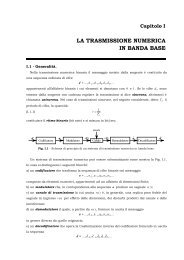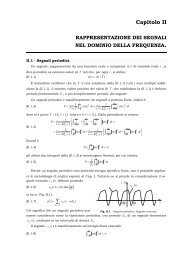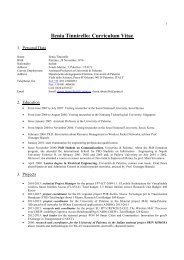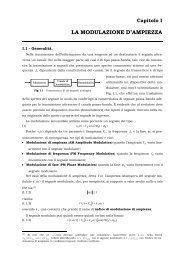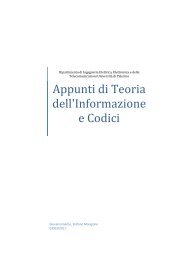NI USB 6008.pdf
NI USB 6008.pdf
NI USB 6008.pdf
You also want an ePaper? Increase the reach of your titles
YUMPU automatically turns print PDFs into web optimized ePapers that Google loves.
USER GUIDE AND SPECIFICATIONS<br />
<strong>NI</strong> <strong>USB</strong>-6008/6009<br />
Introduction<br />
This guide describes how to use the National Instruments <strong>USB</strong>-6008/6009<br />
data acquisition (DAQ) devices and lists specifications.<br />
The <strong>NI</strong> <strong>USB</strong>-6008/6009 provides connection to eight analog input (AI)<br />
channels, two analog output (AO) channels, 12 digital input/output (DIO)<br />
channels, and a 32-bit counter with a full-speed <strong>USB</strong> interface.<br />
Note This manual revision updates naming conventions to reflect the conventions used in<br />
<strong>NI</strong>-DAQmx. Table 1 notes the correlation between the old and updated names.<br />
Table 1. Digital Output Driver Type Naming Conventions<br />
Hardware Functionality<br />
Open-drain<br />
Push-pull<br />
<strong>NI</strong>-DAQmx Terminology<br />
Open collector<br />
Active drive
AI Resolution<br />
Table 2. Differences Between the <strong>NI</strong> <strong>USB</strong>-6008 and <strong>NI</strong> <strong>USB</strong>-6009<br />
Feature <strong>NI</strong> <strong>USB</strong>-6008 <strong>NI</strong> <strong>USB</strong>-6009<br />
12 bits differential,<br />
11 bits single-ended<br />
14 bits differential,<br />
13 bits single-ended<br />
Maximum AI Sample Rate,<br />
10 kS/s 48 kS/s<br />
Single Channel *<br />
Maximum AI Sample Rate,<br />
10 kS/s 48 kS/s<br />
Multiple Channels (Aggregate) *<br />
DIO Configuration Open collector Open collector or active drive<br />
*<br />
System dependent.<br />
1<br />
1 Analog 16<br />
<strong>NI</strong> <strong>USB</strong>-6009<br />
8 Inputs, 14-bit, Multifunction I/O<br />
32 Digital 17<br />
1 <strong>USB</strong> Cable Strain Relief<br />
Figure 1. <strong>NI</strong> <strong>USB</strong>-6008/6009<br />
Figure 2. <strong>NI</strong> <strong>USB</strong>-6008/6009 Back View<br />
<strong>NI</strong> <strong>USB</strong>-6008/6009 User Guide and Specifications 2 ni.com
Safety Guidelines<br />
Caution<br />
Operate the hardware only as described in these operating instructions.<br />
The following section contains important safety information that you must<br />
follow when installing and using the <strong>NI</strong> <strong>USB</strong>-6008/6009.<br />
Do not operate the <strong>NI</strong> <strong>USB</strong>-6008/6009 in a manner not specified in this<br />
document. Misuse of the device can result in a hazard. You can compromise<br />
the safety protection built into the device if the device is damaged in any<br />
way. If the device is damaged, contact National Instruments for repair.<br />
Do not substitute parts or modify the device except as described in this<br />
document. Use the device only with the chassis, modules, accessories, and<br />
cables specified in the installation instructions. You must have all covers<br />
and filler panels installed during operation of the device.<br />
Do not operate the device in an explosive atmosphere or where there may<br />
be flammable gases or fumes. If you must operate the device in such an<br />
environment, it must be in a suitably rated enclosure.<br />
If you need to clean the device, use a dry cloth. Make sure that the device<br />
is completely dry and free from contaminants before returning it to service.<br />
Operate the device only at or below Pollution Degree 2. Pollution is foreign<br />
matter in a solid, liquid, or gaseous state that can reduce dielectric strength<br />
or surface resistivity. The following is a description of pollution degrees:<br />
• Pollution Degree 1 means no pollution or only dry, nonconductive<br />
pollution occurs. The pollution has no influence.<br />
• Pollution Degree 2 means that only nonconductive pollution occurs in<br />
most cases. Occasionally, however, a temporary conductivity caused<br />
by condensation must be expected.<br />
• Pollution Degree 3 means that conductive pollution occurs, or dry,<br />
nonconductive pollution occurs that becomes conductive due to<br />
condensation.<br />
You must insulate signal connections for the maximum voltage for which<br />
the device is rated. Do not exceed the maximum ratings for the device. Do<br />
not install wiring while the device is live with electrical signals. Do not<br />
remove or add connector blocks when power is connected to the system.<br />
Avoid contact between your body and the connector block signal when hot<br />
swapping modules. Remove power from signal lines before connecting<br />
them to or disconnecting them from the device.<br />
© National Instruments Corporation 3 <strong>NI</strong> <strong>USB</strong>-6008/6009 User Guide and Specifications
Operate the device at or below the Measurement Category I 1 . Measurement<br />
circuits are subjected to working voltages 2 and transient stresses<br />
(overvoltage) from the circuit to which they are connected during<br />
measurement or test. Measurement categories establish standard impulse<br />
withstand voltage levels that commonly occur in electrical distribution<br />
systems. The following is a description of measurement categories:<br />
• Measurement Category I is for measurements performed on circuits<br />
not directly connected to the electrical distribution system referred to<br />
as MAINS 3 voltage. This category is for measurements of voltages<br />
from specially protected secondary circuits. Such voltage<br />
measurements include signal levels, special equipment, limited-energy<br />
parts of equipment, circuits powered by regulated low-voltage sources,<br />
and electronics.<br />
• Measurement Category II is for measurements performed on circuits<br />
directly connected to the electrical distribution system. This category<br />
refers to local-level electrical distribution, such as that provided by a<br />
standard wall outlet (for example, 115 V for U.S. or 230 V for Europe).<br />
Examples of Measurement Category II are measurements performed<br />
on household appliances, portable tools, and similar E Series devices.<br />
• Measurement Category III is for measurements performed in the<br />
building installation at the distribution level. This category refers to<br />
measurements on hard-wired equipment such as equipment in fixed<br />
installations, distribution boards, and circuit breakers. Other examples<br />
are wiring, including cables, bus-bars, junction boxes, switches,<br />
socket-outlets in the fixed installation, and stationary motors with<br />
permanent connections to fixed installations.<br />
• Measurement Category IV is for measurements performed at the<br />
primary electrical supply installation (
Software<br />
Software support for the <strong>NI</strong> <strong>USB</strong>-6008/6009 for Windows 2000/XP/Vista<br />
is provided by <strong>NI</strong>-DAQmx.<br />
The <strong>NI</strong>-DAQmx CD contains example programs that you can use to get<br />
started programming with the <strong>NI</strong> <strong>USB</strong>-6008/6009. Refer to the <strong>NI</strong>-DAQmx<br />
for <strong>USB</strong> Devices Getting Started Guide, that shipped with your device and<br />
is also accessible from Start»All Programs»National Instruments»<br />
<strong>NI</strong>-DAQ for more information.<br />
Note For information about non-Windows operating system support, refer to<br />
ni.com/info and enter rddqld.<br />
LabVIEW SignalExpress for DAQ<br />
The <strong>NI</strong>-DAQmx CD includes LabVIEW SignalExpress for DAQ which is<br />
an interactive, measurement software tool for quickly acquiring, analyzing,<br />
and presenting data with no programming required. The application is<br />
available at Start»All Programs»National Instruments»<strong>NI</strong> DAQ»<br />
LabVIEW SignalExpress.<br />
© National Instruments Corporation 5 <strong>NI</strong> <strong>USB</strong>-6008/6009 User Guide and Specifications
Hardware<br />
The following block diagram shows key functional components of the<br />
<strong>NI</strong> <strong>USB</strong>-6008/6009.<br />
Full-Speed <strong>USB</strong> Interface<br />
Vbus<br />
<strong>USB</strong><br />
External<br />
Power<br />
Supply<br />
<strong>USB</strong> Microcontroller<br />
+5 V/200 mA<br />
PFI 0<br />
P1.<br />
P0.<br />
Digital I/O Terminal Block<br />
+2.5 V/CAL<br />
8 Channel<br />
12/14b ADC<br />
SPI<br />
12b DAC<br />
12b DAC<br />
AI <br />
AO 0<br />
AO 1<br />
Analog I/O Terminal Block<br />
Figure 3. Device Block Diagram<br />
<strong>NI</strong> <strong>USB</strong>-6008/6009 User Guide and Specifications 6 ni.com
Setting Up Hardware<br />
Complete the following steps to set up the hardware:<br />
1. Install combicon screw terminal blocks by inserting them into the<br />
combicon jacks.<br />
2. Figure 4 illustrates the signal labels that ship in the <strong>NI</strong> <strong>USB</strong>-6008/6009<br />
kit. You can apply the signal labels to the screw terminal blocks for<br />
easy signal identification.<br />
3<br />
4<br />
1<br />
ANALOG<br />
DIGITAL<br />
2<br />
1 Terminal Number Labels (Use Both Together)<br />
2 Digital I/O Label<br />
3 Single-Ended Label (Use Either)<br />
4 Differential Label (Use Either)<br />
Figure 4. <strong>NI</strong> <strong>USB</strong>-6008/6009 Signal Labels<br />
3. Refer to Table 3 and Figures 4 and 5 for signal label orientation and<br />
affix the provided signal labels to the screw terminal blocks. Until the<br />
signal labels are applied, you can insert the screw terminal blocks into<br />
either of the combicon jacks.<br />
© National Instruments Corporation 7 <strong>NI</strong> <strong>USB</strong>-6008/6009 User Guide and Specifications
igita<br />
1<br />
4<br />
2 3<br />
1<br />
D 7<br />
3 l<br />
3<br />
2<br />
<strong>NI</strong> <strong>USB</strong>-6009<br />
8 Inputs, 14-bit, Multifunction I/O<br />
2<br />
1 A nalo g<br />
1 6<br />
1 Overlay Label with Pin Orientation Guides<br />
2 Combicon Jack<br />
3 Signal Labels<br />
4 <strong>USB</strong> Cable<br />
Figure 5. Signal Label Application Diagram<br />
Note Once you label the screw terminal blocks, you must only insert them into the<br />
matching combicon jack, as indicated by the overlay label on the <strong>NI</strong> <strong>USB</strong>-6008/6009<br />
device.<br />
4. Connect the wiring to the appropriate screw terminals.<br />
<strong>NI</strong> <strong>USB</strong>-6008/6009 User Guide and Specifications 8 ni.com
I/O Connector<br />
The <strong>NI</strong> <strong>USB</strong>-6008/6009 ships with one detachable screw terminal block for<br />
analog signals and one detachable screw terminal block for digital signals.<br />
These terminal blocks provide 16 connections that use 16 AWG to<br />
28 AWG wire.<br />
Table 3 lists the analog terminal assignments, and Table 4 lists the digital<br />
terminal assignments.<br />
Table 3. Analog Terminal Assignments<br />
Module<br />
Terminal<br />
Signal,<br />
Single-Ended Mode<br />
Signal,<br />
Differential Mode<br />
1 GND GND<br />
2 AI 0 AI 0+<br />
3 AI 4 AI 0–<br />
4 GND GND<br />
1 2 3 4 5 6 7 8 9 10 11 12 13 14 15 16<br />
5 AI 1 AI 1+<br />
6 AI 5 AI 1–<br />
7 GND GND<br />
8 AI 2 AI 2+<br />
9 AI 6 AI 2–<br />
10 GND GND<br />
11 AI 3 AI 3+<br />
12 AI 7 AI 3–<br />
13 GND GND<br />
14 AO 0 AO 0<br />
15 AO 1 AO 1<br />
16 GND GND<br />
© National Instruments Corporation 9 <strong>NI</strong> <strong>USB</strong>-6008/6009 User Guide and Specifications
Table 4. Digital Terminal Assignments<br />
Module Terminal Signal<br />
17 P0.0<br />
18 P0.1<br />
19 P0.2<br />
32 31 30 29 28 27 26 25 24 23 22 21 20 19 18 17<br />
20 P0.3<br />
21 P0.4<br />
22 P0.5<br />
23 P0 6<br />
24 P0.7<br />
25 P1.0<br />
26 P1.1<br />
27 P1.2<br />
28 P1.3<br />
29 PFI 0<br />
30 +2.5 V<br />
31 +5 V<br />
32 GND<br />
<strong>NI</strong> <strong>USB</strong>-6008/6009 User Guide and Specifications 10 ni.com
Signal Descriptions<br />
Table 5 describes the signals available on the I/O connectors.<br />
Table 5. Signal Descriptions<br />
Signal Name Reference Direction Description<br />
GND — — Ground—The reference point for the<br />
single-ended AI measurements, bias<br />
current return point for differential mode<br />
measurements, AO voltages, digital<br />
signals at the I/O connector, +5 VDC<br />
supply, and the +2.5 VDC reference.<br />
AI Varies Input Analog Input Channels 0 to 7—For<br />
single-ended measurements, each signal is<br />
an analog input voltage channel. For<br />
differential measurements, AI 0 and AI 4<br />
are the positive and negative inputs of<br />
differential analog input channel 0.<br />
The following signal pairs also form<br />
differential input channels:<br />
, , and<br />
.<br />
AO 0 GND Output Analog Channel 0 Output—Supplies the<br />
voltage output of AO channel 0.<br />
AO 1 GND Output Analog Channel 1 Output—Supplies the<br />
voltage output of AO channel 1.<br />
P1.<br />
P0.<br />
GND<br />
Input or<br />
Output<br />
Digital I/O Signals—You can<br />
individually configure each signal as an<br />
input or output.<br />
+2.5 V GND Output +2.5 V External Reference—Provides a<br />
reference for wrap-back testing.<br />
+5 V GND Output +5 V Power Source—Provides +5 V<br />
power up to 200 mA.<br />
PFI 0 GND Input PFI 0—This pin is configurable as either a<br />
digital trigger or an event counter input.<br />
© National Instruments Corporation 11 <strong>NI</strong> <strong>USB</strong>-6008/6009 User Guide and Specifications
LED<br />
The <strong>NI</strong> <strong>USB</strong>-6008/6009 device has a green LED next to the <strong>USB</strong><br />
connector. When the device is connected to a <strong>USB</strong> port, the LED blinks<br />
steadily to indicate that the device is initialized and is receiving power from<br />
the connection.<br />
If the LED is not blinking, it may mean that the device is not initialized or<br />
the computer is in standby mode. In order for the device to be recognized,<br />
the device must be connected to a computer that has <strong>NI</strong>-DAQmx installed<br />
on it. If your device is not blinking, make sure your computer has the latest<br />
version of <strong>NI</strong>-DAQmx installed on it, and the computer is not in standby<br />
mode.<br />
Analog Input<br />
Analog Input Circuitry<br />
You can connect analog input signals to the <strong>NI</strong> <strong>USB</strong>-6008/6009 through<br />
the I/O connector. Refer to Table 5 for more information about connecting<br />
analog input signals.<br />
Figure 6 illustrates the analog input circuitry of the <strong>NI</strong> <strong>USB</strong>-6008/6009.<br />
+2.5 V REF<br />
AI<br />
127 kΩ<br />
30.9 kΩ MUX PGA<br />
ADC<br />
AI FIFO<br />
39.2 kΩ<br />
Input Range<br />
Selection<br />
MUX<br />
Figure 6. Analog Input Circuitry<br />
The <strong>NI</strong> <strong>USB</strong> 6008/6009 has one analog-to-digital converter (ADC). The<br />
multiplexer (MUX) routes one AI channel at a time to the PGA.<br />
<strong>NI</strong> <strong>USB</strong>-6008/6009 User Guide and Specifications 12 ni.com
Analog Input Modes<br />
PGA<br />
The progammable-gain amplifier provides input gains of 1, 2, 4, 5, 8,<br />
10, 16, or 20 when configured for differential measurements and gain<br />
of 1 when configured for single-ended measurements. The PGA gain is<br />
automatically calculated based on the voltage range selected in the<br />
measurement application.<br />
A/D Converter<br />
The analog-to-digital converter (ADC) digitizes the AI signal by<br />
converting the analog voltage into a digital code.<br />
AI FIFO<br />
The <strong>NI</strong> <strong>USB</strong>-6008/6009 can perform both single and multiple A/D<br />
conversions of a fixed or infinite number of samples. A first-in-first-out<br />
(FIFO) buffer holds data during AI acquisitions to ensure that no data<br />
is lost.<br />
You can configure the AI channels on the <strong>NI</strong> <strong>USB</strong>-6008/6009 to take<br />
single-ended or differential measurements. Refer to Table 5 for more<br />
information about I/O connections for single-ended or differential<br />
measurements.<br />
Connecting Differential Voltage Signals<br />
For differential signals, connect the positive lead of the signal to the AI+<br />
terminal, and the negative lead to the AI– terminal.<br />
AI+<br />
Voltage<br />
Source<br />
<strong>NI</strong> <strong>USB</strong>-6008/6009<br />
AI–<br />
Figure 7. Connecting a Differential Voltage Signal<br />
© National Instruments Corporation 13 <strong>NI</strong> <strong>USB</strong>-6008/6009 User Guide and Specifications
The differential input mode can measure ±20 V signals in the ±20 V range.<br />
However, the maximum voltage on any one pin is ±10 V with respect to<br />
GND. For example, if AI 1 is +10 V and AI 5 is –10 V, then the<br />
measurement returned from the device is +20 V.<br />
20<br />
15<br />
10<br />
Amplitude (V)<br />
5<br />
0<br />
–5<br />
–10<br />
AI 1<br />
AI 5<br />
Result<br />
–15<br />
–20<br />
Figure 8. Example of a Differential 20 V Measurement<br />
Connecting a signal greater than ±10 V on either pin results in a clipped<br />
output.<br />
20<br />
15<br />
10<br />
Amplitude (V)<br />
5<br />
0<br />
–5<br />
–10<br />
AI 1<br />
AI 5<br />
Result<br />
–15<br />
–20<br />
Figure 9. Exceeding ±10 V on AI Returns Clipped Output<br />
<strong>NI</strong> <strong>USB</strong>-6008/6009 User Guide and Specifications 14 ni.com
Connecting Reference Single-Ended Voltage Signals<br />
To connect reference single-ended voltage signals (RSE) to the<br />
<strong>NI</strong> <strong>USB</strong>-6008/6009, connect the positive voltage signal to the desired<br />
AI terminal, and the ground signal to a GND terminal.<br />
When no signals are connected to the analog input terminal, the internal<br />
resistor divider may cause the terminal to float to approximately 1.4 V<br />
when the analog input terminal is configured as RSE. This behavior is<br />
normal and does not affect the measurement when a signal is connected.<br />
AI<br />
Voltage<br />
Source<br />
<strong>NI</strong> <strong>USB</strong>-6008/6009<br />
GND<br />
Figure 10. Connecting a Reference Single-Ended Voltage Signal<br />
Digital Trigger<br />
When an AI task is defined, you can configure PFI 0 as a digital trigger<br />
input. When the digital trigger is enabled, the AI task waits for a rising or<br />
falling edge on PFI 0 before starting the acquisition. To use ai/Start Trigger<br />
with a digital source, specify PFI 0 as the source and select rising or falling<br />
edge.<br />
© National Instruments Corporation 15 <strong>NI</strong> <strong>USB</strong>-6008/6009 User Guide and Specifications
Analog Output<br />
Analog Output Circuitry<br />
The <strong>NI</strong> <strong>USB</strong>-6008/6009 has two independent AO channels that can<br />
generate outputs from 0–5 V. All updates of AO lines are software-timed.<br />
Figure 11 illustrates the analog output circuitry for the <strong>NI</strong> <strong>USB</strong>-6008/6009.<br />
+5 V<br />
REF(+) REF(–)<br />
12-Bit<br />
DAC<br />
Output<br />
Buffer<br />
50 Ω<br />
AO<br />
GND<br />
DACs<br />
Connecting Analog Output Loads<br />
Figure 11. Analog Output Circuitry<br />
Digital-to-analog converts (DACs) convert digital codes to analog<br />
voltages.<br />
To connect loads to the <strong>NI</strong> <strong>USB</strong>-6008/6009, connect the positive lead of the<br />
load to the AO terminal, and connect the ground of the load to a GND<br />
terminal.<br />
AI<br />
Voltage<br />
Source<br />
<strong>NI</strong> <strong>USB</strong>-6008/6009<br />
GND<br />
Figure 12. Connecting a Load<br />
<strong>NI</strong> <strong>USB</strong>-6008/6009 User Guide and Specifications 16 ni.com
Minimizing Glitches on the Output Signal<br />
Digital I/O<br />
Digital I/O Circuitry<br />
When you use a DAC to generate a waveform, you may observe glitches in<br />
the output signal. These glitches are normal; when a DAQ switches from<br />
one voltage to another, it produces glitches due to released charges. The<br />
largest glitches occur when the most significant bit of the DAC code<br />
changes. You can build a lowpass deglitching filter to remove some of<br />
these glitches, depending on the frequency and nature of the output signal.<br />
Refer to ni.com/support for more information about minimizing<br />
glitches.<br />
The <strong>NI</strong> <strong>USB</strong>-6008/6009 has 12 digital lines, P0. and P1.,<br />
which comprise the DIO port. GND is the ground-reference signal for the<br />
DIO port. You can individually program all lines as inputs or outputs.<br />
Figure 13 shows P0. connected to example signals configured as<br />
digital inputs and digital outputs. You can configure P1. similarly.<br />
+5 V<br />
1<br />
LED<br />
2<br />
3<br />
4<br />
LED<br />
+5 V<br />
Switch<br />
TTL Signal<br />
P0.0<br />
P0.1<br />
P0.2<br />
P0.3<br />
P0.4<br />
P0.5<br />
P0.6<br />
P0.7<br />
I/O Connector<br />
GND<br />
1 P0.0 configured as an open collector digital output driving a LED<br />
2 P0.2 configured as a active drive digital output driving a LED<br />
3 P0.4 configured as a digital input receiving a TTL signal from a gated invertor<br />
4 P0.7 configured as a digital input receiving a 0 V or 5 V signal from a switch<br />
Figure 13. Example of Connecting a Load<br />
© National Instruments Corporation 17 <strong>NI</strong> <strong>USB</strong>-6008/6009 User Guide and Specifications
Caution Exceeding the maximum input voltage ratings or maximum output ratings, which<br />
are listed in the Specifications section, can damage the DAQ device and the computer.<br />
National Instruments is not liable for any damage resulting from such signal connections.<br />
Source/Sink Information<br />
The default configuration of the <strong>NI</strong> <strong>USB</strong>-6008/6009 DIO ports is open<br />
collector, allowing 5 V operation, with an onboard 4.7 kΩ pull-up resistor.<br />
An external, user-provided, pull-up resistor can be added to increase the<br />
source current drive up to a 8.5 mA limit per line as shown in Figure 14.<br />
The <strong>NI</strong> <strong>USB</strong>-6009 ports can also be configured as active drive using the<br />
DAQmx API, allowing 3.3 V operation with a source/sink current limit of<br />
±8.5 mA. Refer to the <strong>NI</strong>-DAQmx Help for more information about how to<br />
set the DIO configuration.<br />
+5 V<br />
<strong>NI</strong> <strong>USB</strong>-6008/6009<br />
+5 V<br />
Re<br />
External<br />
Pull-up<br />
Resistor<br />
P0.0<br />
Rp<br />
4.7 KΩ Onboard Resistor<br />
Port Pad<br />
Rl<br />
Load<br />
A<br />
GND<br />
Figure 14. Example of Connecting External User-Provided Resistor<br />
Complete the following steps to determine the value of the user-provided<br />
pull-up resistor:<br />
1. Place an ammeter in series with the load.<br />
2. Place a variable resistor between the digital output line and the +5 V.<br />
3. Adjust the variable resistor until the ammeter current reads as the<br />
intended current. The intended current must be less than 8.5 mA.<br />
4. Remove the ammeter and variable resistor from your circuit.<br />
5. Measure the resistance of the variable resistor. The measured<br />
resistance is the ideal value of the pull-up resistor.<br />
<strong>NI</strong> <strong>USB</strong>-6008/6009 User Guide and Specifications 18 ni.com
6. Select a static resistor value for your pull-up resistor that is greater than<br />
or equal to the ideal resistance.<br />
7. Re-connect the load circuit and the pull-up resistor.<br />
I/O Protection<br />
To protect the <strong>NI</strong> <strong>USB</strong>-6008/6009 against overvoltage, undervoltage, and<br />
overcurrent conditions, as well as ESD events, you should avoid these fault<br />
conditions by using the following guidelines:<br />
• If you configure a DIO line as an output, do not connect it to any<br />
external signal source, ground signal, or power supply.<br />
• If you configure a DIO line as an output, understand the current<br />
requirements of the load connected to these signals. Do not exceed<br />
the specified current output limits of the DAQ device.<br />
National Instruments has several signal conditioning solutions for<br />
digital applications requiring high current drive.<br />
• If you configure a DIO line as an input, do not drive the line with<br />
voltages outside of its normal operating range. The DIO lines have<br />
a smaller operating range than the AI signals.<br />
• Treat the DAQ device as you would treat any static sensitive device.<br />
Always properly ground yourself and the equipment when handling<br />
the DAQ device or connecting to it.<br />
Power-On States<br />
Static DIO<br />
At system startup and reset, the hardware sets all DIO lines to<br />
high-impedance inputs. The DAQ device does not drive the signal<br />
high or low. Each line has a weak pull-up resistor connected to it.<br />
Each of the <strong>NI</strong> <strong>USB</strong>-6008/6009 DIO lines can be used as a static DI or DO<br />
line. You can use static DIO lines to monitor or control digital signals. All<br />
samples of static DI lines and updates of DO lines are software-timed.<br />
Event Counter<br />
You can configure PFI 0 as a source for a gated invertor counter input edge<br />
count task. In this mode, falling-edge events are counted using a 32-bit<br />
counter. For more information about event timing requirements, refer to the<br />
Specifications section.<br />
© National Instruments Corporation 19 <strong>NI</strong> <strong>USB</strong>-6008/6009 User Guide and Specifications
Reference and Power Sources<br />
+2.5 External References<br />
+5 V Power Source<br />
The <strong>NI</strong> <strong>USB</strong>-6008/6009 creates an external reference and supplies a power<br />
source. All voltages are relative to COM unless otherwise noted.<br />
The <strong>NI</strong> <strong>USB</strong>-6008/6009 creates a high-purity reference voltage supply for<br />
the ADC using a multi-state regulator, amplifier, and filter circuit. The<br />
resulting +2.5 V reference voltage can be used as a signal for self test.<br />
The <strong>NI</strong> <strong>USB</strong>-6008/6009 supplies a 5 V, 200 mA output. This source can be<br />
used to power external components.<br />
Note<br />
While the device is in <strong>USB</strong> suspend, the output is disabled.<br />
Specifications<br />
The following specifications are typical at 25 °C, unless otherwise noted.<br />
Analog Input<br />
Converter type ........................................Successive approximation<br />
Analog inputs..........................................8 single-ended, 4 differential,<br />
software selectable<br />
Input resolution<br />
<strong>NI</strong> <strong>USB</strong>-6008...................................12 bits differential,<br />
11 bits single-ended<br />
<strong>NI</strong> <strong>USB</strong>-6009...................................14 bits differential,<br />
13 bits single-ended<br />
Max sampling rate 1<br />
<strong>NI</strong> <strong>USB</strong>-6008...................................10 kS/s<br />
<strong>NI</strong> <strong>USB</strong>-6009...................................48 kS/s<br />
AI FIFO ..................................................512 bytes<br />
Timing resolution ...................................41.67 ns (24 MHz timebase)<br />
1<br />
System dependent.<br />
<strong>NI</strong> <strong>USB</strong>-6008/6009 User Guide and Specifications 20 ni.com
Timing accuracy..................................... 100 ppm of actual sample rate<br />
Input range<br />
Single-ended ................................... ±10 V<br />
Differential...................................... ±20 V 1 , ±10 V, ±5 V, ±4 V,<br />
±2.5 V, ±2 V, ±1.25 V, ±1 V<br />
Working voltage..................................... ±10 V<br />
Input impedance..................................... 144 kΩ<br />
Overvoltage protection........................... ±35<br />
Trigger source ........................................ Software or external digital<br />
trigger<br />
System noise 2<br />
Single-ended<br />
±10 V range ............................. 5 mVrms<br />
Differential<br />
±20 V range............................. 5 mVrms<br />
±1 V range ............................... 0.5 mVrms<br />
Absolute accuracy at full scale, single ended<br />
Range<br />
Typical at 25 °C<br />
(mV)<br />
Maximum over Temperature<br />
(mV)<br />
±10 14.7 138<br />
Absolute accuracy at full scale, differential 3<br />
Range<br />
Typical at 25 °C<br />
(mV)<br />
Maximum over Temperature<br />
(mV)<br />
±20 14.7 138<br />
±10 7.73 84.8<br />
±5 4.28 58.4<br />
±4 3.59 53.1<br />
±2.5 2.56 45.1<br />
1<br />
±20 V means that |AI+ – (AI–)|
Range<br />
Typical at 25 °C<br />
(mV)<br />
Maximum over Temperature<br />
(mV)<br />
Analog Output<br />
±2 2.21 42.5<br />
±1.25 1.70 38.9<br />
±1 1.53 37.5<br />
Analog outputs........................................2<br />
Output resolution ....................................12 bits<br />
Maximum update rate.............................150 Hz, software-timed<br />
Output range ...........................................0 to +5 V<br />
Output impedance...................................50 Ω<br />
Output current drive................................5 mA<br />
Power-on state ........................................0 V<br />
Slew rate .................................................1 V/μs<br />
Short circuit current ................................50 mA<br />
Absolute accuracy (no load) ...................7 mV typical, 36.4 mV maximum<br />
at full scale<br />
Digital I/O<br />
Digital I/O<br />
P0. .........................................8 lines<br />
P1. .........................................4 lines<br />
Direction control.....................................Each channel individually<br />
programmable as input or output<br />
Output driver type<br />
<strong>NI</strong> <strong>USB</strong>-6008...................................Open collector (open-drain)<br />
<strong>NI</strong> <strong>USB</strong>-6009...................................Each channel individually<br />
programmable as active drive<br />
(push-pull) or open collector<br />
(open-drain)<br />
<strong>NI</strong> <strong>USB</strong>-6008/6009 User Guide and Specifications 22 ni.com
Compatibility ......................................... TTL, LVTTL, CMOS<br />
Absolute maximum voltage range ......... –0.5 to 5.8 V with respect to GND<br />
Pull-up resistor ....................................... 4.7 kΩ to 5 V<br />
Power-on state........................................ Input<br />
Digital logic levels<br />
Level Min Max Units<br />
Input low voltage<br />
Input high voltage<br />
Input leakage current<br />
–0.3<br />
2.0<br />
—<br />
0.8<br />
5.8<br />
50<br />
V<br />
V<br />
μA<br />
Output low voltage (I = 8.5 mA)<br />
Output high voltage<br />
Active drive (push-pull), I = –8.5 mA<br />
Open collector (open-drain), I = –0.6 mA, nominal<br />
Open collector (open-drain), I = –8.5 mA, with external<br />
pull-up resistor<br />
—<br />
2.0<br />
2.0<br />
2.0<br />
0.8<br />
3.5<br />
5.0<br />
—<br />
V<br />
V<br />
V<br />
V<br />
External Voltage<br />
+5 V output (200 mA maximum) .......... +5 V typical, +4.85 V minimum<br />
+2.5 V output (1 mA maximum) ........... +2.5 V typical<br />
+2.5 V accuracy ..................................... 0.25% max<br />
Reference temperature drift ................... 50 ppm/°C max<br />
Counter<br />
Number of counters................................ 1<br />
Resolution .............................................. 32 bits<br />
Counter measurements........................... Edge counting (falling-edge)<br />
Counter direction.................................... Count up<br />
Pull-up resistor ....................................... 4.7 kΩ to 5 V<br />
Maximum input frequency..................... 5 MHz<br />
Minimum high pulse width.................... 100 ns<br />
Minimum low pulse width ..................... 100 ns<br />
© National Instruments Corporation 23 <strong>NI</strong> <strong>USB</strong>-6008/6009 User Guide and Specifications
Input high voltage...................................2.0 V<br />
Input low voltage ....................................0.8 V<br />
Bus Interface<br />
<strong>USB</strong> specification ...................................<strong>USB</strong> 2.0 full-speed<br />
Power Requirements<br />
Physical Characteristics<br />
<strong>USB</strong> bus speed........................................12 Mb/s<br />
<strong>USB</strong><br />
4.10 to 5.25 VDC.............................80 mA typical, 500 mA max<br />
<strong>USB</strong> suspend ...................................300 μA typical, 500 μA max<br />
If you need to clean the module, wipe it with a dry towel.<br />
Dimensions<br />
Without connectors..........................6.35 cm × 8.51 cm × 2.31 cm<br />
(2.50 in. × 3.35 in. × 0.91 in.)<br />
With connectors...............................8.18 cm × 8.51 cm × 2.31 cm<br />
(3.22 in. × 3.35 in. × 0.91 in.)<br />
I/O connectors.........................................<strong>USB</strong> series B receptacle,<br />
(2) 16 position terminal block<br />
plug headers<br />
Weight<br />
With connectors...............................84 g (3 oz)<br />
Without connectors..........................54 g (1.9 oz)<br />
Screw-terminal wiring ............................16 to 28 AWG<br />
Torque for screw terminals.....................0.22–0.25 N · m<br />
(2.0–2.2 lb · in.)<br />
<strong>NI</strong> <strong>USB</strong>-6008/6009 User Guide and Specifications 24 ni.com
Safety<br />
Standards<br />
The <strong>NI</strong> <strong>USB</strong>-6008/6009 is designed to meet the requirements of the<br />
following standards of safety for electrical equipment for measurement,<br />
control, and laboratory use:<br />
• IEC 61010-1, EN 61010-1<br />
• UL 61010-1, CSA 61010-1<br />
Note For UL and other safety certifications, refer to the product label, or visit<br />
ni.com/certification, search by model number or product line, and click the<br />
appropriate link in the Certification column.<br />
Voltages<br />
Connect only voltages that are within these limits.<br />
Channel-to-GND.................................... ±30 V max,<br />
Measurement Category I<br />
Measurement Category I is for measurements performed on circuits not<br />
directly connected to the electrical distribution system referred to as<br />
MAINS voltage. MAINS is a hazardous live electrical supply system that<br />
powers equipment. This category is for measurements of voltages from<br />
specially protected secondary circuits. Such voltage measurements include<br />
signal levels, special equipment, limited-energy parts of equipment,<br />
circuits powered by regulated low-voltage sources, and electronics.<br />
Caution Do not use this module for connection to signals or for measurements within<br />
Measurement Categories II, III, or IV.<br />
Hazardous Locations<br />
The <strong>NI</strong> <strong>USB</strong>-6008/6009 are not certified for use in hazardous locations.<br />
Environmental<br />
The <strong>NI</strong> <strong>USB</strong>-6008/6009 device is intended for indoor use only.<br />
Operating temperature<br />
(IEC 60068-2-1 and IEC 60068-2-2) ..... 0 to 55 °C<br />
Operating humidity<br />
(IEC 60068-2-56)................................... 5 to 95% RH, noncondensing<br />
Maximum altitude .................................. 2,000 m (at 25 °C ambient<br />
temperature)<br />
© National Instruments Corporation 25 <strong>NI</strong> <strong>USB</strong>-6008/6009 User Guide and Specifications
Electromagnetic Compatibility<br />
Storage temperature<br />
(IEC 60068-2-1 and IEC 60068-2-2)......–40 to 85 °C<br />
Storage humidity<br />
(IEC 60068-2-56) ..................................5 to 90% RH, noncondensing<br />
Pollution Degree (IEC 60664)................2<br />
This product is designed to meet the requirements of the following<br />
standards of EMC for electrical equipment for measurement, control,<br />
and laboratory use:<br />
• EN 61326 EMC requirements; Minimum Immunity<br />
• EN 55011 Emissions; Group 1, Class A<br />
• CE, C-Tick, ICES, and FCC Part 15 Emissions; Class A<br />
Note The <strong>NI</strong> <strong>USB</strong>-6008/6009 may experience temporary variations in analog input<br />
readings when exposed to radiated and conducted RF noise. The device returns to normal<br />
operation after RF exposure is removed.<br />
Note<br />
For EMC compliance, operate this device according to product documentation.<br />
CE Compliance<br />
This product meets the essential requirements of applicable European<br />
Directives, as amended for CE marking, as follows:<br />
• 73/23/EEC; Low-Voltage Directive (safety)<br />
• 89/336/EEC; Electromagnetic Compatibility Directive (EMC)<br />
Note Refer to the Declaration of Conformity (DoC) for this product for any additional<br />
regulatory compliance information. To obtain the DoC for this product, visit ni.com/<br />
certification, search by model number or product line, and click the appropriate link<br />
in the Certification column.<br />
Waste Electrical and Electronic Equipment (WEEE)<br />
EU Customers At the end of their life cycle, all products must be sent to a WEEE recycling<br />
center. For more information about WEEE recycling centers and National Instruments<br />
WEEE initiatives, visit ni.com/environment/weee.htm.<br />
<strong>NI</strong> <strong>USB</strong>-6008/6009 User Guide and Specifications 26 ni.com
Where to Go for Support<br />
The National Instruments Web site is your complete resource for technical<br />
support. At ni.com/support you have access to everything from<br />
troubleshooting and application development self-help resources to email<br />
and phone assistance from <strong>NI</strong> Application Engineers.<br />
A Declaration of Conformity (DoC) is our claim of compliance with the<br />
Council of the European Communities using the manufacturer’s<br />
declaration of conformity. This system affords the user protection for<br />
electronic compatibility (EMC) and product safety. You can obtain the DoC<br />
for your product by visiting ni.com/certification. If your product<br />
supports calibration, you can obtain the calibration certificate for your<br />
product at ni.com/calibration.<br />
National Instruments corporate headquarters is located at<br />
11500 North Mopac Expressway, Austin, Texas, 78759-3504.<br />
National Instruments also has offices located around the world to help<br />
address your support needs. For telephone support in the United States,<br />
create your service request at ni.com/support and follow the calling<br />
instructions or dial 512 795 8248. For telephone support outside the United<br />
States, contact your local branch office:<br />
Australia 1800 300 800, Austria 43 662 457990-0,<br />
Belgium 32 (0) 2 757 0020, Brazil 55 11 3262 3599,<br />
Canada 800 433 3488, China 86 21 5050 9800,<br />
Czech Republic 420 224 235 774, Denmark 45 45 76 26 00,<br />
Finland 385 (0) 9 725 72511, France 01 57 66 24 24,<br />
Germany 49 89 7413130, India 91 80 41190000, Israel 972 3 6393737,<br />
Italy 39 02 413091, Japan 81 3 5472 2970, Korea 82 02 3451 3400,<br />
Lebanon 961 (0) 1 33 28 28, Malaysia 1800 887710,<br />
Mexico 01 800 010 0793, Netherlands 31 (0) 348 433 466,<br />
New Zealand 0800 553 322, Norway 47 (0) 66 90 76 60,<br />
Poland 48 22 3390150, Portugal 351 210 311 210, Russia 7 495 783 6851,<br />
Singapore 1800 226 5886, Slovenia 386 3 425 42 00,<br />
South Africa 27 0 11 805 8197, Spain 34 91 640 0085,<br />
Sweden 46 (0) 8 587 895 00, Switzerland 41 56 2005151,<br />
Taiwan 886 02 2377 2222, Thailand 662 278 6777,<br />
Turkey 90 212 279 3031, United Kingdom 44 (0) 1635 523545<br />
National Instruments, <strong>NI</strong>, ni.com, and LabVIEW are trademarks of National Instruments Corporation.<br />
Refer to the Terms of Use section on ni.com/legal for more information about National<br />
Instruments trademarks. Other product and company names mentioned herein are trademarks or trade<br />
names of their respective companies. For patents covering National Instruments products, refer to the<br />
appropriate location: Help»Patents in your software, the patents.txt file on your CD, or<br />
ni.com/patents.<br />
© 2004–2007 National Instruments Corporation. All rights reserved. 371303H-01 Jun07


